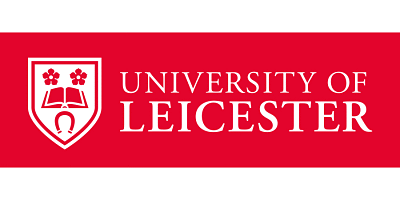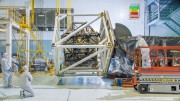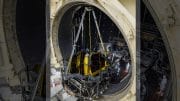Leicester space scientists will join a group of global experts investigating fundamental questions about our Universe, after being granted time to use the most advanced observatory ever built.
A total of 286 scientific targets identified by astronomers and planetary scientists at the University of Leicester were selected from more than 1,000 submitted by researchers from 44 countries, for a portion of the 6,000 observing hours available in the first year of operation (Cycle 1) for the James Webb Space Telescope (JWST).
Considered the successor to the Hubble Space Telescope, the JWST will launch in late 2021 and will begin delivering a flood of scientific data in 2022, after the spacecraft unfolds its 6.5m-diameter mirror, travels 1.5 million km from Earth, and checks the functioning of all of its instruments.
Leicester researchers will use the JWST for a number of projects, examining how stars and planets form, identifying new galaxies, and attempting to answer the question of how liquid water – a key building block of life as we know it – is transported through space.
Professor Emma Bunce is head of the University’s School of Physics and Astronomy and President of the Royal Astronomical Society. She said:
“The James Webb Space Telescope is such a highly-anticipated tool for astronomers across the world – and we’re absolutely no different in looking forward to the first batch of science data in 2022.
“We’re all very excited to see so many Leicester projects allocated time for science on such a high-profile mission, especially given the University’s involvement in building one of its key instruments.
“We look forward to the scheduled launch later this year and afterwards to using the JWST to answer key science questions about the Universe – including topics relating to high-energy astrophysics, exoplanets and our own solar system.”
- Professor Nial Tanvir and Dr Rhaana Starling are co-investigators (co-Is) of a programme which will use spectroscopy to map the distribution of elements formed by gamma-ray bursts.
Gamma-ray bursts are brief flashes of high energy that signal the death of a massive star or the merger of two neighbouring stars and are the greatest explosions in the Universe since the Big Bang.
These events pinpoint the location of distant star-forming galaxies that would otherwise go undetected and, through observing 10 host galaxies of gamma-ray bursts at a time in the Universe’s history known as ‘cosmic noon’, the researchers will hope to build on our understanding of star formation.
- Professor Paul O’Brien is a co-I on a proposal to observe the electromagnetic counterpart of a gravitational wave event in order to study the production of so-called heavy elements including gold, silver and strontium. This is a Target of Opportunity proposal to be triggered should a gravitational wave event be observed during Cycle 1.
- Dr Tuomo Tikkanen and Dr John Pye are co-Is in the ‘PRIMER’ (Public Release IMaging for Extragalactic Research) programme, one of the largest in Cycle 1.
PRIMER will provide the astronomical community with an early, large-area JWST infrared imaging survey to revolutionise our knowledge of early galaxy and black-hole formation and evolution out to the highest redshifts yet probed. The PRIMER survey is predicted to reveal around 120,000 galaxies, the majority of which are expected to be newly discovered.
- Dr Michael Roman is co-I on a proposal to study the sub-Neptune exoplanet GJ1214b, which will observe the emission spectra from GJ1214b over a full orbit using the MIRI instrument which Leicester helped to build. Combined with near-IR observations, these will provide powerful constraints on GJ1214b’s atmospheric composition and structure, which remains obscured in transmission spectra likely owing to thick hazes of gas.
- Dr Giovanni Rosotti is a co-I on a proposal to use water as a tracer of pebble delivery to rocky planets. This research will observe water lines in the mid infrared in a few proto-planetary discs around young stars. This water is believed to be released by pebbles, as they drift from the cold, outer regions of the discs toward the warmer regions around the star. Scientists aim to test this hypothesis by using JWST to measure the water content in the terrestrial planet-forming region and linking it with the pebbles in the outer disc traced through ground-based observations.
- Dr Leigh Fletcher is a principal investigator (PI) on a target-of-opportunity programme to observe Jupiter and/or Saturn in the event of an enormous impact (like Shoemaker-Levy 9 in 1994, or the Wesley impactor in 2009), or a rare storm event.
Observations will rely on triggers from the amateur community in order to understand the atmospheric physics and chemistry at work. The proposal calls for observations from the MIRI instrument and the Near Infrared Spectrograph (NIRSpec).
Dr Fletcher is also co-I on a programme to observe Neptune in the mid-infrared with MIRI, to study how the planet’s dynamic storms affect its temperature and composition over short spans of time.
- These GO programmes supplement the guaranteed-time (GTO) and early-release science (ERS) proposals in Solar System science. Dr Fletcher is set to lead programmes to study the outer planets including Jupiter’s famous Great Red Spot, Saturn’s summer pole and rings, and to acquire global mid-IR maps of Uranus and Neptune to reveal the properties of their stratospheres for the first time.
- Finally, Dr Henrik Melin and Dr Fletcher are co-Is on an ERS programme to study Jupiter’s atmosphere and satellite system as an early test of Webb’s capabilities to explore bright, extended, rotating targets.
The James Webb Space Telescope is a joint project of NASA, the European Space Agency and the Canadian Space Agency. The University of Leicester Space Research Centre, in the School of Physics and Astronomy, has provided the Mechanical Engineering Lead for the Mid-Infrared Instrument (MIRI) on board the space telescope.
The University of Leicester has a long record of space research, dating back more than 60 years. During that time the University’s experts have flown 90 instruments in space and there has been at least one Leicester-built instrument operating in orbit continuously since 1967. There are currently eight operational Leicester-built experiments in space.
Space Park Leicester, due to open in 2021, is currently being developed by the University of Leicester in collaboration with local, national and international partners. The new facility will provide state-of-the-art, high-tech facilities for research, innovation and new educational pathways. There are also plans for a commercial Low Cost Access to Space (LoCAS) satellite manufacturing facility for the manufacture of mid-range satellites.
Meanwhile;
- The BepiColombo mission to Mercury (due to arrive 2025) will fly past Venus in August and make its first flyby of Mercury in October – the first of six which will place it in orbit around Mercury in January 2025. Leicester is leading the main instrument on the mission to study the composition of the surface of the planet.
- Leicester scientists and engineers recently delivered a completely new type of super-lightweight X-ray telescope mirror to be carried on board the Chinese-French satellite observatory SVOM, which will examine gamma-ray bursts.
- A Leicester-built instrument is due to land on Mars in 2022 as part of the ESA Rosalind Franklin Rover.
Source : University of Leicester








Be the first to comment on "Leicester astronomers look ahead to first light from James Webb Space Telescope"